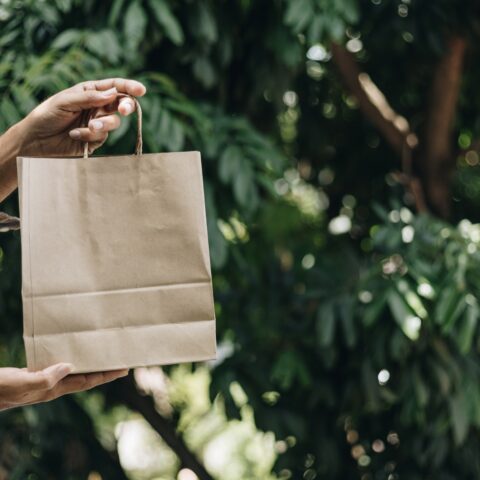Take The Paleo Diet onto the Trails

Hitting the trail has been a favorite human pastime since the age of our hunter-gatherer ancestors. [1] These days, however, our walks in the wild are more about fun than survival.
But before you grab trail mix packed with peanuts and M&Ms, remember that the best snacks for your long walk should maximize energy—and not threaten to melt along the way.
Ready to pack your backpack? Here’s how to take The Paleo Diet® out on your next hike.
Four questions to ask before packing your snacks
While we think your hiking snacks ought to be Paleo, there’s more at play. Factors like food safety, weight, caloric density, and more should also come into consideration.
1. Is it perishable?
When you’re outdoors all day, you won’t have access to a refrigerator or even a cooler (unless you want to lug one along with you). So hiking snacks need to be able to withstand ambient temperatures without spoiling. If you’re only going to be out for an hour, perishability doesn’t matter as much—so feel free to pack last night’s leftovers. But for anything beyond a couple of hours, go for shelf-stable options.
2. Is it heavy?
Everything that comes with you into the backcountry must be carried there, so the lighter the food, the better. That’s why dried fruits, veggies, and meats are so popular with the hiking set: Without their water content, heavy or bulky foods become much easier to pack (and last a lot longer, too).
3. Will it last?
Delicate snacks won’t last long stuffed inside a backpack. Sturdy, whole fruits and veggies will fare better than anything that can be smushed, so think apples and carrots over fresh berries and tomatoes. If you’re really craving something soft, you can pack it inside a glass or plastic hard-sided container to protect it—but you’ll pay a weight penalty for that.
4. Is it nutrient dense?
Hiking is hard work, so you’ll need nutritious foods to replace lost calories and keep energy levels high. Snacks like jerky, nuts, and seeds deliver a lot of calories in small, easy-to-carry packages.
Our favorite Paleo-friendly backpacking snacks
Jerky
Beef jerky is a hiker classic for a reason: It’s lightweight, shelf stable, and packs about 100 calories per ounce*. But watch out for commercial jerkies, which can be full of excess salt, sugar, and additives. It’s simple to make your own in a small dehydrator or oven. And don’t feel confined to beef jerky—you can also buy (or make) jerky from pork, elk, bison, turkey, or even salmon.
Fish
Speaking of salmon, fish can be very trail friendly. Go for tuna or salmon packed in lightweight pouches rather than cans, or stash small tins of sardines in your backpack.
Nuts and seeds
Easy to pack, full of nutrients, and stuffed with energy, nuts are about as perfect a trail food as you can get. Consider macadamia nuts (203 calories per ounce), walnuts (185 calories per ounce), almonds (165 calories per ounce), or cashews (163 calories per ounce). Some nut butters also come in backpack-friendly pouches and pair nicely with apple slices or carrots.
Fruits and veggies
Fresh greens might not last long in your backpack, but avocados (which have 34 calories per ounce, plus healthy fats) might be up for the challenge. While they’re somewhat durable, you might want to stash extra ripe ones near the top of your backpack to prevent squishing. Apples, oranges, pears, carrots, and bell peppers also travel well.
Dried fruits
These hiking staples are prized for their light weight and concentrated nutrients. Think Medjool dates (66 calories per date), apricots, prunes, mango, cherries, raisins, and apples.
Trail mix
You’ll get several top Paleo ingredients in every handful of a delicious trail mix, which combines nuts, seeds, and dried fruits. However, you might want to make your own fresh blends to avoid additives and to ensure you’re staying 100-percent Paleo. Try this herb-y, spicy party nut mix, or toss your favorites together for a custom blend. And a sprinkling of dark chocolate adds nutrients aplenty and a decadent flavor (just be careful it doesn’t melt).
Energy bars
Homemade trail bars and balls are a close cousin of trail mix, in an even more packable form. Try whipping up these seasonal pumpkin spice date balls or no-bake energy bars for an on-the-go treat.
Happy trails!
*All calorie information in this article comes from USDA FoodData Central.
References
[1] O’Keefe, James H., et al. “Achieving hunter-gatherer fitness in the 21st century: back to the future.” The American journal of medicine 123.12 (2010): 1082-1086. (Link: https://www.sciencedirect.com/science/article/abs/pii/S0002934310004638)
Elisabeth Kwak-Hefferan
Elisabeth Kwak-Hefferan is a Montana-based freelance journalist who specializes in the outdoors, science, environment, and parenting.
More About The Author




